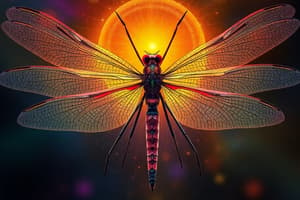Podcast
Questions and Answers
What is the common name for Coleoptera?
What is the common name for Coleoptera?
- Ants
- Lacewings
- Beetles (correct)
- Moths
Dermaptera undergo a complete lifecycle.
Dermaptera undergo a complete lifecycle.
False (B)
What are the larvae of Diptera called?
What are the larvae of Diptera called?
Maggots, leaf-miners
Hemiptera are commonly known as true bugs.
Hemiptera are commonly known as true bugs.
Which of the following are common names of Homoptera?
Which of the following are common names of Homoptera?
Hymenoptera includes ants, bees, and wasps.
Hymenoptera includes ants, bees, and wasps.
What are the larvae of Lepidoptera called?
What are the larvae of Lepidoptera called?
Neuroptera undergo an incomplete lifecycle.
Neuroptera undergo an incomplete lifecycle.
Which of the following is a common name for Orthoptera?
Which of the following is a common name for Orthoptera?
What does Thysanoptera commonly refer to?
What does Thysanoptera commonly refer to?
What environmental factors affect insect development?
What environmental factors affect insect development?
The greatest effect on insect activity is due to __________.
The greatest effect on insect activity is due to __________.
How does humidity affect insects?
How does humidity affect insects?
What is the impact of rain and wind on insects?
What is the impact of rain and wind on insects?
Flashcards are hidden until you start studying
Study Notes
Insect Classification
-
Coleoptera: Includes beetles and weevils; their larvae are known as grubs, borers, or rootworms; undergo a complete life cycle.
-
Dermaptera: Commonly referred to as earwigs; they exhibit an incomplete life cycle.
-
Diptera: Encompasses flies and midges; larvae are referred to as maggots and leaf-miners; complete life cycle is observed.
-
Hemiptera: Known as true bugs, including bed bugs and stink bugs; they have an incomplete life cycle.
-
Homoptera: Features aphids, scale insects, whiteflies, mealybugs, leafhoppers, and spittle bugs; these insects also have an incomplete life cycle.
-
Hymenoptera: Covers ants, bees, wasps, and sawflies; they undergo a complete life cycle.
-
Lepidoptera: This order comprises moths and butterflies; larvae are called caterpillars, hornworms, armyworms, and cutworms; complete life cycle is present.
-
Neuroptera: Contains lacewings and fishflies; these insects have a complete life cycle.
-
Orthoptera: Consists of grasshoppers, crickets, and cockroaches; they display an incomplete life cycle.
-
Thysanoptera: Commonly known as thrips; they also have an incomplete life cycle.
Environmental Factors Influencing Insect Development
-
Temperature: The most significant factor affecting insect activity; heat units and degree days can forecast insect life stages.
-
Humidity: Refers to water vapor in the air; many insects are adversely affected during dry spells.
-
Rain and Wind: Heavy rainfall can threaten insect survival; this environmental factor is vital for the dispersal of insect populations.
Studying That Suits You
Use AI to generate personalized quizzes and flashcards to suit your learning preferences.




